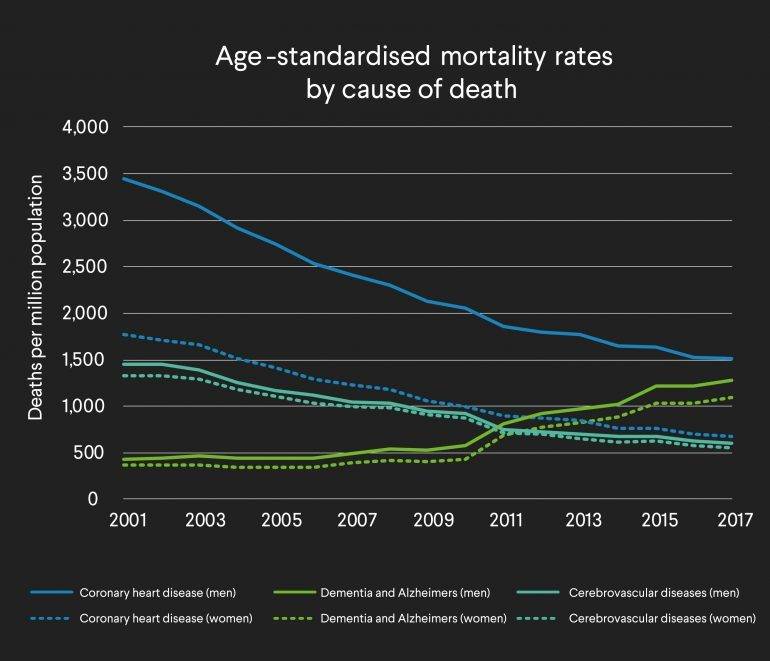In this regular column, Club Vita's longevity experts will help you visualise the often abstract world of longevity risk by introducing their own personal favourite charts.
In this edition Conor O'Reilly explores recent trends on cause of death statistics.
Question:
What are the largest causes of death in England & Wales and how have they been changing?
Answer:
Overall, dementia and Alzheimer’s disease is the biggest killer in England & Wales and is on the rise. Heart disease is still the biggest killer of men, but is on the decline and is significantly lower for women. The chart below shows how age standardised mortality rates (expressed as deaths per million population) for the three leading causes of death in England & Wales have changed since 2001.

Source: ONS data on registered deaths in England & Wales, by age, sex, selected underlying causes of death and the leading causes of death for both males and females
Key takeaways
- Death rates from coronary heart disease have fallen significantly, particularly for men. However, there are signs of this levelling off since around 2011.
- Women see significantly fewer deaths from coronary heart disease than men.
- Deaths due to dementia and Alzheimer’s disease have increased significantly since 2010 and are now overall the biggest killer. However, some of this increase may be due to a change in coding and incentives to diagnose.
Death rates from coronary heart disease have fallen steadily over the period, to around 45% of the 2001 level for men. However, while still falling, there are signs of this levelling off over the period since 2011. In addition, women see significantly fewer deaths from coronary heart disease than men.
The clear stand out from the chart is the recent rise in dementia and Alzheimer’s disease deaths, with a marked increase since 2010. This could be partly due to the recoding of vascular dementia deaths away from circulatory disease in 2011 or even to a recent focus on encouraging diagnosis, including short periods of financial incentives. Alternatively, it may just be the case that more people are typically living to older ages.
The key questions for pension funds and insurers are:
- What is driving the experience of different causes of death?
- How likely are these drivers to persist in the short, medium, and longer term?
- Are these drivers likely to affect pension funds members generally, and particularly different socio-economic groups, to the extent seen in the population data?
What do you think?
Please post your questions in our Friends of Club Vita discussion group on LinkedIn.
Top Charts Issue 9: Trends in causes of death
Download a print friendly version of this article




